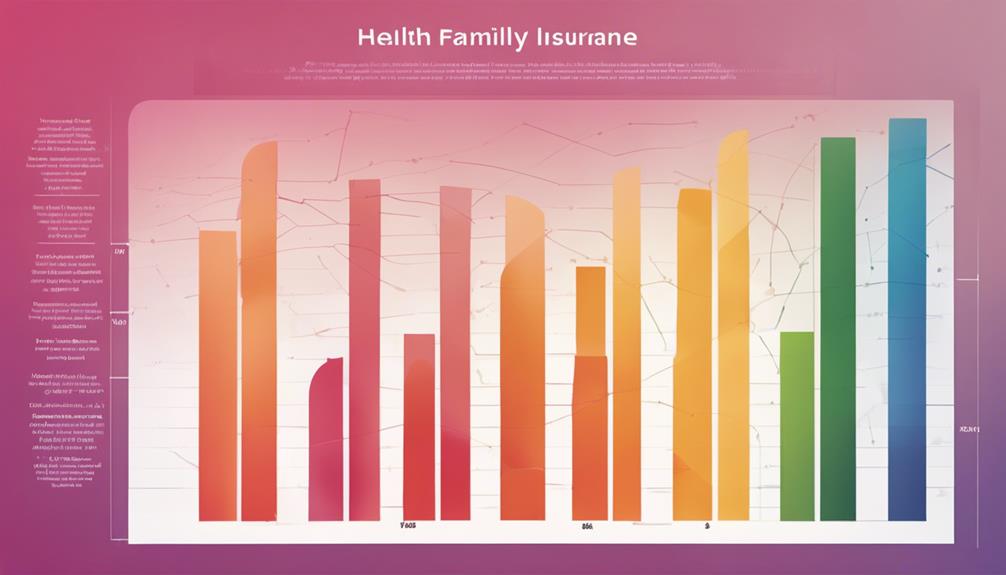Health insurance costs can vary widely. On average, individual Bronze plans run about $350 monthly, while Gold plans can average $500. For families, monthly premiums range from $400 to over $1,200, depending on factors like location and coverage type. Premiums are generally higher for older adults and urban families due to increased healthcare demands. Employer-sponsored plans might have lower premiums but could come with higher deductibles. Consider evaluating your specific health needs and comparing various plans to find the best fit for your budget. By exploring your options, you can make a more informed choice.
Overview of Health Insurance Costs

Understanding the factors that influence health insurance costs can help you make informed decisions about your coverage options. One key factor is healthcare inflation, which impacts what you pay each month. As medical costs rise, insurers adjust premiums to keep up with these expenses. This means that even if your health needs remain stable, your monthly cost might increase due to broader market trends.
Another important aspect is plan customization. Many insurance providers now offer flexible plans that allow you to tailor coverage to your specific needs. While this can lead to better satisfaction and potentially lower costs, it also requires you to carefully evaluate what services you truly need.
You might find that opting for a higher deductible or fewer included services can lower your premium, but be cautious; you don't want to compromise essential coverage for short-term savings.
Factors Influencing Premiums
Numerous factors drive the premiums you pay for health insurance, including your age, location, and the specific plan you choose. Insurers use premium rating systems to determine how much you'll pay. Generally, younger individuals tend to have lower premiums, while older adults face higher costs due to increased health risks. Geographic location also plays a significant role; urban areas often have higher premiums than rural ones due to varying healthcare costs and provider availability.
The specific health plan you select directly impacts your premium as well. Plans with extensive coverage or lower deductibles usually come with higher premiums. Additionally, insurers apply underwriting criteria, which assess your health status, lifestyle, and medical history. This process helps them gauge the risk of insuring you and adjust your premium accordingly. For instance, if you smoke or have pre-existing conditions, you might see increased costs.
Understanding these factors can help you make informed decisions about your health insurance. By being aware of how age, location, and plan specifics affect your premium, you can better navigate your options and potentially find a more affordable solution.
Average Monthly Premiums by Plan Type

When considering health insurance, it's essential to understand the differences in average monthly premiums between individual and family plans.
Individual plans typically have lower premiums, but family plans may offer better value for those with multiple dependents.
Knowing these averages can help you make informed choices that align with your budget and healthcare needs.
Individual Plan Premiums
Individual health insurance plan premiums vary greatly based on factors like coverage level, age, and location, making it vital to analyze average monthly costs by plan type.
Generally, you'll find that plans categorized as Bronze, Silver, Gold, and Platinum have distinct premium costs. Bronze plans typically feature the lowest premiums but higher out-of-pocket expenses, while Platinum plans offer the highest premiums with lower deductibles and out-of-pocket costs.
For instance, as of late 2023, the average monthly premium for a Bronze plan can hover around $350, while Gold plans may average up to $500. Your age also plays a significant role; younger individuals often pay less compared to older adults.
Additionally, location can greatly impact your premium; urban areas might have higher costs due to increased demand for healthcare services.
If you qualify, premium assistance programs can help reduce your monthly costs, making individual health insurance more affordable.
It's important to evaluate your specific needs, budget, and the available plans in your area to choose the best option for your health coverage.
Family Plan Premiums
Comparing family plan premiums reveals significant variations based on factors such as coverage tier, family size, and geographical location, making it essential for families to carefully assess their options. Typically, family coverage can cost anywhere from $400 to over $1,200 per month. The differences stem from the type of plan chosen—such as Health Maintenance Organizations (HMOs) or Preferred Provider Organizations (PPOs)—and the level of coverage selected.
As you evaluate your options, keep in mind that premium increases can occur annually, reflecting changes in healthcare costs and the insurer's claims experience. Larger families often face higher premiums due to the increased likelihood of medical expenses, while families in urban areas may encounter steeper costs compared to those in rural regions.
Additionally, consider the trade-offs between lower premiums and higher deductibles versus higher premiums with lower out-of-pocket costs. Understanding these dynamics will help you make an informed choice that best fits your family's healthcare needs and budget.
Costs Based on Age and Location
Health insurance costs vary greatly based on age and geographic location, impacting your monthly premiums and coverage options.
Age demographics play an important role in determining your insurance rates. Typically, younger individuals experience lower premiums, while older adults face higher costs due to increased health risks. Insurers evaluate these age groups differently, often charging those over 50 considerably more than their younger counterparts.
In addition to age, regional variations further influence your health insurance expenses. Insurance companies consider factors like local healthcare costs, population health statistics, and even state regulations when setting premiums. For example, if you reside in an area with high medical service costs, you might pay more compared to someone living in a region with lower healthcare expenses.
Moreover, certain states have implemented their own health insurance mandates or subsidies, affecting pricing and available plans. As a result, understanding the interplay between your age and location is vital for accurately predicting your health insurance costs.
Employer-Sponsored Vs. Marketplace Plans

When evaluating your health insurance options, you'll notice significant differences between employer-sponsored plans and marketplace plans.
Each type offers unique cost structures, coverage options, and premium payment methods that can impact your monthly expenses.
Understanding these distinctions is essential for making an informed choice that suits your needs and budget.
Cost Comparison Analysis
Many individuals find themselves weighing the costs of employer-sponsored plans against those available on the marketplace to determine which option offers better value for their specific needs.
When you analyze these two types of plans, it's important to take into account policy variations and deductible impacts that can greatly affect your overall expenses.
Employer-sponsored plans often have lower monthly premiums but may feature higher deductibles. This means you could pay less upfront, but you might face larger out-of-pocket costs when seeking care.
Marketplace plans, on the other hand, usually offer a broader range of options, allowing you to select a plan that aligns with your health care needs. However, their premium costs can vary widely, and lower premiums often come with higher deductibles.
It's vital to calculate your expected healthcare usage and how each plan's structure will impact your finances. Factor in not just the premiums but also out-of-pocket maximums, copays, and coinsurance rates.
Coverage Options Differences
Employer-sponsored plans typically offer a more limited selection of coverage options compared to marketplace plans, which provide greater flexibility in tailoring benefits to fit your individual health needs. When you choose an employer-sponsored plan, you're often restricted to specific coverage types dictated by your employer. This means your options may not fully align with your personal medical requirements.
Marketplace plans, on the other hand, allow you to compare various plans that feature different coverage types, from basic to extensive. This can include specialized services or alternative treatments that might be excluded in employer plans.
Additionally, policy limitations are often more pronounced in employer-sponsored plans. They might impose stricter rules regarding out-of-network providers or limit the number of covered visits for certain services. With marketplace plans, you can review and select a policy that aligns more closely with your needs, thereby reducing potential gaps in coverage.
Ultimately, understanding these differences can help you make a more informed decision about which type of plan suits you best, ensuring that your health needs are adequately met without unnecessary restrictions.
Premium Payment Structures
Premium payment structures vary considerably between employer-sponsored plans and marketplace options, impacting your overall healthcare costs and budgeting strategies.
In employer-sponsored plans, premium payment methods typically involve shared costs between you and your employer. This often results in lower monthly premiums when compared to marketplace plans, where you're responsible for the full premium amount.
Marketplace plans offer a wider variety of options but can lead to higher monthly payments. These plans often feature various deductible structures, meaning you may have to pay more out-of-pocket before your insurance kicks in. While some marketplace options provide subsidies based on your income, which can reduce your premium costs, the variability can make budgeting challenging.
Understanding these differences is essential for financial planning. If you choose an employer-sponsored plan, you'll likely benefit from lower premiums and predictable costs.
On the other hand, a marketplace plan may offer more flexibility regarding coverage but could lead to higher expenses, especially if you're not eligible for subsidies. Evaluating these premium payment structures will help you make informed decisions about your healthcare costs.
Government Programs and Their Costs
Government programs like Medicaid and Medicare play an essential role in providing affordable health insurance options, often catering to low-income individuals and the elderly at greatly reduced costs. Understanding both programs is vital for you, especially if you or someone you know may qualify.
Medicaid eligibility typically includes low-income families, pregnant women, children, and individuals with disabilities. The program varies by state, but it generally covers a broad range of services, including hospital visits, preventive care, and prescription drugs. Since Medicaid is state-funded, costs can differ greatly based on your location.
On the other hand, Medicare serves those aged 65 and older, along with certain younger individuals with disabilities. Medicare costs can include premiums, deductibles, and co-pays, but many beneficiaries find these expenses manageable compared to private insurance.
There are different plan types within Medicare, such as Part A (hospital insurance) and Part B (medical insurance), which can impact your overall expenses.
Tips for Choosing Affordable Coverage

When selecting affordable health insurance coverage, it's crucial to assess your specific healthcare needs and budget to find a plan that balances cost with necessary services. Start by outlining your expected medical expenses, including regular check-ups, medications, and any specialized care. This will help you determine what coverage is vital.
Next, explore the insurance marketplace to compare different plans. Look for options that fit your budget while providing the necessary services. Pay attention to premiums, deductibles, and out-of-pocket maximums; understanding these costs will help you make a more informed decision.
Utilize budgeting strategies to manage healthcare expenses effectively. Consider setting aside a portion of your income for medical costs, which can cushion unexpected bills.
Also, research subsidies available in the marketplace, as they can notably reduce your premium costs based on your income.
Conclusion
In conclusion, understanding how much health insurance costs per month is vital for making informed decisions.
By considering factors like age, location, and plan type, you can better assess your options.
Whether you choose employer-sponsored plans or marketplace coverage, it's important to evaluate your needs and budget carefully.
Exploring government programs may also reveal affordable alternatives.
Ultimately, being proactive and well-informed can help you secure the coverage you need without breaking the bank.
